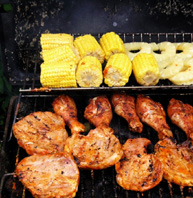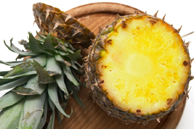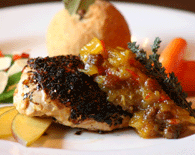Summer 2006: To Your Health
In this Issue:
- Celebrating National Men’s Health Week: June 12-18
- The Truth about Saw Palmetto & Prostate Health
- Safe Grilling- Tips to Keep Your Food Safe This Summer
- Nutritional Care for Breastfeeding Moms: World Breastfeeding Week, August 1-7
- Stay Cool: Exercising Safely in the Summer Heat
- Feature Food of the Month: Pineapple
- Healthy Recipe: Pineapple Salsa
Celebrating National Men’s Health Week: June 12-18, 2006
 On March 31, 1994, President Bill Clinton signed a bill establishing National Men’s Health Week. The goal of Men’s Health Week is to increase awareness of preventative diseases and to encourage early detection and treatment for men and boys. It also alerts the media, policy makers, and health care providers to encourage men and boys to become more aware of their health by scheduling regular medical check-ups. This edition of To Your Health Newsletter will address prostate health in celebration of National Men’s Health Week.
On March 31, 1994, President Bill Clinton signed a bill establishing National Men’s Health Week. The goal of Men’s Health Week is to increase awareness of preventative diseases and to encourage early detection and treatment for men and boys. It also alerts the media, policy makers, and health care providers to encourage men and boys to become more aware of their health by scheduling regular medical check-ups. This edition of To Your Health Newsletter will address prostate health in celebration of National Men’s Health Week.
The Truth about Saw Palmetto & Prostate Health
 Saw Palmetto (Serenoa repens) has become a popular over-the-counter supplement used to treat benign prostatic hyperplasia (BPH). BPH is a progressive enlargement of the prostate associated with many changes, which include voiding disturbance and obstruction. This condition causes the cells of the prostate to overgrow and apply pressure to the urethra–the tube that carries urine from the bladder, resulting in decreased urine flow and/or frequent urges to urinate. A recent study in the Journal of Prostate Cancer and Prostatic Diseases evaluated 75 patients aged 52 – 78 years old with mild/moderate BPH experiencing lower urinary tract symptoms. Fifty-seven of the participants were given 160 mg of saw palmetto twice daily for 9 weeks. The remaining participants did not receive the supplements and acted as the control subjects. Participants were evaluated before and after the trial for maximum urinary flow rate and bladder pressure. The results of the study indicated that treatment with saw palmetto improved urinary function with few side effects. It produced a rapid improvement in the holding and storage of urine in the bladder and the rate of movement of urine out of the bladder. Although it is not fully understood just how this herb functions in the body, it is believed that its oily compounds have various hormonal and anti-inflammatory effects. While the use of this herb may sound very promising, it is recommended that you consult your doctor first to test for BPH if you have any discomforting urinary/bladder symptoms.
Saw Palmetto (Serenoa repens) has become a popular over-the-counter supplement used to treat benign prostatic hyperplasia (BPH). BPH is a progressive enlargement of the prostate associated with many changes, which include voiding disturbance and obstruction. This condition causes the cells of the prostate to overgrow and apply pressure to the urethra–the tube that carries urine from the bladder, resulting in decreased urine flow and/or frequent urges to urinate. A recent study in the Journal of Prostate Cancer and Prostatic Diseases evaluated 75 patients aged 52 – 78 years old with mild/moderate BPH experiencing lower urinary tract symptoms. Fifty-seven of the participants were given 160 mg of saw palmetto twice daily for 9 weeks. The remaining participants did not receive the supplements and acted as the control subjects. Participants were evaluated before and after the trial for maximum urinary flow rate and bladder pressure. The results of the study indicated that treatment with saw palmetto improved urinary function with few side effects. It produced a rapid improvement in the holding and storage of urine in the bladder and the rate of movement of urine out of the bladder. Although it is not fully understood just how this herb functions in the body, it is believed that its oily compounds have various hormonal and anti-inflammatory effects. While the use of this herb may sound very promising, it is recommended that you consult your doctor first to test for BPH if you have any discomforting urinary/bladder symptoms.
Reference:
Al-Shukri, SH, Deschaseaux, P, et al. Early urodynamic effects of the lipido-sterolic extract of Serenoa repens (Permixon®) in patients with lower urinary tract symptoms due to benign prostatic hyperplasia. Prostate Cancer and Prostatic Diseases (2000), 3, 195-199
For information on Prostate Cancer screening, please visit our special web section.
Safe Grilling: Keep Your Foods Safe This Summer
 Cancer researchers have linked eating grilled meat, poultry, and fish with health risks. Grilling and broiling cause “muscle meats” (red meat, poultry, and fish) to produce cancer-causing compounds. These compounds, called HCAs (herterocyclic amines), have been shown to cause tumors in animals and possibly increase the risk of cancers of the breast, colon, stomach, and prostate in humans.
Cancer researchers have linked eating grilled meat, poultry, and fish with health risks. Grilling and broiling cause “muscle meats” (red meat, poultry, and fish) to produce cancer-causing compounds. These compounds, called HCAs (herterocyclic amines), have been shown to cause tumors in animals and possibly increase the risk of cancers of the breast, colon, stomach, and prostate in humans.
When fat from meat, poultry or fish drips onto hot coals or stones, another cancer-causing substance is formed. PAHs (polycyclic aromatic hydrocarbons) are deposited back onto food through smoke and flare-ups.
However, there is no need to eliminate grilling and broiling completely. As the summer and the beginning of the grilling season approaches, follow these tips to limit the formation of HCAs and PAHs when you grill.
Safe Grilling:
- Marinating meats before grilling may significantly reduce the amount of HCAs. Marinate
in the refrigerator, not on the counter or outdoors. If you plan on using some of the
marinade on the cooked food, set aside a portion prior to adding raw meats. - Use different utensils and platters for raw and cooked foods.
- Try grilling marinated vegetables on a skewer, grilling tray, or wrapped in foil instead of
muscle meats. Grilled fruits also make a sweet, healthy dessert. - Trim the fat. Choose lean, well-trimmed meats to grill; they have less fat to drip into the
flames. Remove the skin from poultry. Avoid high fat meats such as ribs or sausages. - Pre-cook meats, fish and poultry in the oven or microwave, then briefly grill for flavor. Make sure the food goes immediately onto the hot grill after being partially cooked in the microwave, oven or stovetop.
- Keep meat portions small so they only need to spend a brief time on the grill. Skewered
kebobs cook the fastest. - Fix the drips. Avoid letting juices drip into the flames or coals, which causes smoke and
flare-ups. Use tongs or a spatula to turn foods, instead of piercing meat with a fork. Keep
a spray bottle handy to control flare-ups, and cover the grill with punctured aluminum foil
to reduce drips. - Flip frequently. Research has found that cooking hamburger patties at a lower
temperature and turning them often accelerates the cooking process, helps prevent the
formation of HCAs and is equally effective in killing bacteria. - Grilled food can be kept hot until served by moving it to the side of the grill rack, just away from the coals where it can overcook.
- Cook meat to its proper internal temperature to avoid germs such as E-Coli and
Salmonella, which can cause severe illness and even deathFood Item
Internal Temperature
Chicken, ground 165ºF
Chicken, breast 170ºF
Chicken, whole
(take measurement in thigh)180ºF
Hamburgers, beef 160ºF
Fin Fish* 145ºF
Hot Dogs 140ºF
Beef or Veal Steaks** 145-170ºF
*Flesh should be opaque in color and should separate easily with a fork.
**145ºF for medium rare; 160ºF for medium; 170ºF for well done.
Reference:
U.S. Food and Drug Administration
Click here for Food Safety Tips for Outdoor Summer Eating
To learn about The Benefits of Marinating and to try a Classic Marinade Recipe at your next barbeque, please visit our special web section.
Nutritional Care for Breastfeeding Moms:
World Breastfeeding Week ~August 1-7, 2006
 World Breastfeeding Week (WBW) was developed by the World Alliance for Breastfeeding Action that protects, promotes, and supports breastfeeding. The organization is based on the World Health Organization and UNICEF’s global strategy on Infant and Young Child Feeding. The organization strives to inform the public on the benefits of breastfeeding, as well as re-establishing and maintaining a breastfeeding culture.
World Breastfeeding Week (WBW) was developed by the World Alliance for Breastfeeding Action that protects, promotes, and supports breastfeeding. The organization is based on the World Health Organization and UNICEF’s global strategy on Infant and Young Child Feeding. The organization strives to inform the public on the benefits of breastfeeding, as well as re-establishing and maintaining a breastfeeding culture.
Breastfeeding can be a rewarding experience for new mothers. As during pregnancy, it is important for mothers to take care of themselves and their baby with proper rest and nutrition. Your lifestyle can affect the breast milk you give to your baby, so it is important to ensure that you are living a health lifestyle.
Nutrition
While many women often begin to improve their diet during pregnancy, continuing to develop good dietary habits after your baby is born is an essential part of remaining healthy for both you and your baby’s future. Oftentimes, improved nutrition will benefit both your mood and energy level—two important aspects of a healthy lifestyle. Women who are undernourished and who have had diets very low in vitamins and minerals and low stores in their bodies, may produce breast milk that is also low in vitamins and minerals, specifically vitamins A, D, B6, or B12. However, breastfeeding mothers can improve their nutrient levels by improving their diets and/or taking vitamin supplements. Nursing mothers are encouraged to consume an additional 500 calories a day than a non-pregnant/non-nursing woman. Eat generous amounts of fruits and vegetables, whole grain breads and cereals, calcium-rich dairy products and protein-rich foods (lean meats, poultry, fish and legumes). When choosing fruits, be sure to choose 2 fruits high in vitamin C and 1 fruit high in vitamin A daily.
Breastfeeding Daily Food Guide
|
Food Group |
# of Servings |
|
Milk, yogurt and cheese |
at least 4 |
|
Meat & Beans |
at least 3 |
|
Vegetables |
3 to 5 |
|
Fruits |
2 to 4 |
|
Grains |
6 to 11 |
|
Fats, Oils, & Sweets |
sparingly |
Fluids
Proper hydration is another way to ensure that you and your baby are at your best. While you do not have to drink an excessive amount of fluid just to have a good milk supply, it is important to consume 8-eight ounce servings of water or a nutritious beverage, such as juice or milk, per day to stay well hydrated and strong. An easy way to remember to get enough fluid is to drink a glass of water every time you feed your baby. While excessive amounts of caffeine (more than five 5 ounce cups of coffee per day) can cause your baby to lose sleep and become fussy, moderate to low intakes of caffeine (fewer than five 5 ounce cups) usually does not cause a problem for most breastfeeding babies.
Allergies
Sometimes your baby can have a reaction to a certain food that you ate, such as spicy foods, foods that can cause gas or dairy foods. Symptoms in your baby to watch for include fussiness, diarrhea, gas, a rash, dry skin, or the baby pulling up his/her knees and screaming. Common foods that cause allergic reactions include peanuts and strawberries. It takes anywhere from 2-6 hours for your body to pass the food you ate and digested into your breast milk. Because of this, it is recommended that you keep a food record in case you notice any of these changes in your baby. Usually, if you stop eating the food that is bothering your baby, the symptoms will go away.
Reference:
Medline Plus
World Breastfeeding Charter
For information on customized meal planning for breastfeeding moms, click here.
Stay Cool: Exercising Safely in the Summer Heat
 The cold days of winter have passed…spring is in the air…and those hot summer days are just around the corner! Take every opportunity to enjoy the extra hours of daylight that summer has to offer and indulge in your favorite outdoor activities! For many of us, this includes playing sports and engaging in physical activities such as running, walking or biking.
The cold days of winter have passed…spring is in the air…and those hot summer days are just around the corner! Take every opportunity to enjoy the extra hours of daylight that summer has to offer and indulge in your favorite outdoor activities! For many of us, this includes playing sports and engaging in physical activities such as running, walking or biking.
While the beautiful weather may motivate us even more to get outdoors, it’s important to keep in mind the potential hazards that come along with exercising in hot weather. If you follow these tips for exercising safely in the summer heat, you can be sure that you are taking advantage of all the fun summer has to offer.
|
DO’S |
DON’TS |
| Stay hydrated! It’s important to drink plenty of fluids throughout the day, limiting your intake of caffeinated beverages. Drink 15-20 minutes before beginning your workout and every 15 minutes while you exercise. | Don’t assume that you are well-hydrated when you are swimming just because you are surrounded by water. Your body can experience loss of fluids even while in water. |
| Feed your body! While the heat may decrease your appetite, it’s important to try to eat 5-6 times per day. Fruits and vegetables will not only help keep you satisfied, but they will help with hydration too. | Don’t try to lose weight by sweating. When your body perspires, it loses water. Therefore, changes in weight will not necessarily be from fat loss. |
| Wear Sunscreen! No matter what time of day you choose to exercise, the sun’s rays can always reach you. Sunburn is not only harmful to your skin, it hinders your ability to stay cool. | Avoid using sunscreen with an SPF lower than 15. The most effective sunscreens have an SPF of 15 or higher and should be re-applied every two hours, especially after swimming or sweating. |
| Wear light, loose-fitting clothing! Cotton is the best choice since it is breathable and absorbs perspiration. Stick with light colors to avoid attracting the sun. | Avoid extreme changes in temperature. Give your body time to cool down before jumping from being hot and sweaty into a cold air-conditioned area. |
| Check the weather! If the heat index is in the dangerous zone, choose an indoor activity to stay cooler instead of heading outdoors. | Avoid strenuous activity during the hottest part of the day, which is between 10 am and 3 pm . |
| Stay in your comfort zone! Stick to activities that you are most comfortable with, and don’t attempt strenuous activity. | Don’t ignore your body’s signals. Heat-related illnesses have warning signs, so be sure to know how to recognize them and what to do. |
Feature Food of the Month – Pineapple
 Originating in South America, the vivid tropical flavor and extraordinary juiciness of pineapple balances sweetness and tartness to make this fruit a pleasure to eat throughout the hot summer months. Not only does fresh pineapple taste good, but it’s also good for you. Pineapple is rich in bromelain, a protein-digesting enzyme that helps with digestion. It helps to reduce inflammation caused by arthritis, gout, and acute sinusitis, and has even been used in experiments as an anti-cancer agent. Pineapple is an excellent source of vitamin C, thiamin, and manganese (an essential trace mineral)—all of which contribute to antioxidant protection, immune support, vision protection, and energy production. To maximize these health benefits, pineapple should be eaten raw, when ripe, not cooked.
Originating in South America, the vivid tropical flavor and extraordinary juiciness of pineapple balances sweetness and tartness to make this fruit a pleasure to eat throughout the hot summer months. Not only does fresh pineapple taste good, but it’s also good for you. Pineapple is rich in bromelain, a protein-digesting enzyme that helps with digestion. It helps to reduce inflammation caused by arthritis, gout, and acute sinusitis, and has even been used in experiments as an anti-cancer agent. Pineapple is an excellent source of vitamin C, thiamin, and manganese (an essential trace mineral)—all of which contribute to antioxidant protection, immune support, vision protection, and energy production. To maximize these health benefits, pineapple should be eaten raw, when ripe, not cooked.
When choosing a pineapple, make sure there are no soft spots or bruises. Once a pineapple is picked, it will not ripen further, so it’s important to look for pineapples that are slightly on the heavy side and have a sweet smell at the stem end. Pineapples can be kept at room temperature for up to two days before serving. After two days, the pineapple should be wrapped in a plastic bag and stored in the refrigerator for a maximum of three to five days. Previously-cut pineapple will remain fresh if stored in an air-tight container in the refrigerator.
Pineapple can be used to sweeten up many recipes or can be consumed as a healthy, tasty snack. With as little as 75 calories per cup, using pineapple is a great way to stay cool and healthy this summer!
Healthy Recipe: Pineapple Salsa
 Ingredients:
Ingredients:
1 cup finely chopped fresh pineapple
2 tablespoons finely chopped red onion
2 tablespoons finely chopped green onion
1 tablespoon finely chopped red bell pepper,
optional
1 tablespoon finely chopped fresh cilantro
1 tablespoon honey
Dash ground red pepper, cayenne or chipotle
2 teaspoons finely minced jalapeno pepper,
optional
1-1½ tablespoons juice of 1 fresh lime
¼ teaspoon black pepper
Instructions:
- Combine all ingredients.
- Cover and refrigerate for an hour or more to blend flavors.
- Serve with grilled or broiled fish.
Yield: 11 servings (approximately 1 1/3 cups)
Serving Size: 2 Tablespoons
Exchange: 2T = Free food
Nutrition Facts:
Calories = 20
Total Fat = 0 grams
Saturated Fat = 0 grams
Cholesterol = 0 milligrams
Protein = 0 grams
Carbohydrate = 5 grams
Sodium = 6 milligrams
Dietary Fiber = 0 grams
For more healthy recipes, click here.

Leave a Reply
Want to join the discussion?Feel free to contribute!